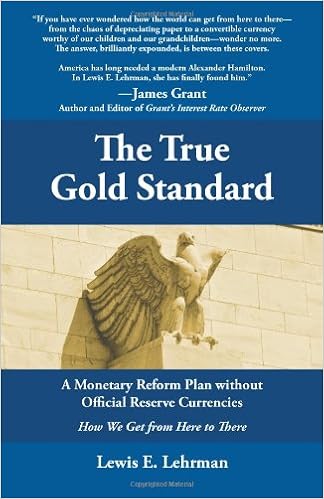
The True Gold Standard - A Monetary Reform Plan without Official Reserve Currencies
Lewis E. Lehrman
Language: English
Pages: 148
ISBN: 0984017801
Format: PDF / Kindle (mobi) / ePub
How We Get from Here to There
This Monetary Reform Plan proposes to establish the framework for an enduring, stable value for the United States dollar; that is, to define the dollar by statute as a certain weight unit of gold to be coined into lawful money.
Long associated with free market prices, mobile factors of production, and free people, a dollar convertible to gold * is warranted by the United States Constitution in Article I, Sections 8 and 10 (see Appendix I). A monetary standard of precious metal (gold and silver) was the institutional monetary foundation, the gyroscope, of the great Industrial Revolution of the western world, giving rise at the birth of the American Republic to a reasonably stable American currency. Wars did interrupt stability and growth. But over the long run, economic productivity and population expansion led to unprecedented prosperity. They were hallmarks of the United States from the Coinage Act of 1792 (see Appendix II) until 1971 when the last vestige of dollar linkage to gold was suspended. Floating paper money exchange rates, mixed with pegged and manipulated exchange rates, have persisted during peace and war to this very day. (Since 1971 average hourly real wages have hardly improved.)
A floating, or pegged paper and credit currency, has proven itself throughout history an unreliable, depreciating store of value. Unlike the paper dollar, a dollar defined in law as a weight unit of gold is the monetary standard which simultaneously provides all the primary functions of true standard money: (1) a stable store of value; (2) a stable measure and unit-of-account; and, (3) a universally accepted means of payment. A gold monetary standard combines, in one monetary article of wealth, the three primary functions of money. Moreover, the true gold standard of history provides the global networking effects of universally acceptable, equitable, ubiquitous, standard money. Through long historical evolution gold became free trade money.
Throughout ancient and modern history it was the unique properties of the gold monetary standard which made it universally acceptable to trading peoples in the market. The test of what The Purpose of The True Gold Standard will endure as honest money can only be studied in the empirical laboratory of human history; mathematical abstractions, drawn from the blackboards of academic economists, will not do. Because trust and universal acceptability are the trademarks of honest money these virtues must be affirmed, in the long run, by the tests of the open market, and then reinforced by wise, limited, and prudent governments which understand and embrace the inductive, tested verdict of the market.
No perfect monetary system can be fashioned in this imperfect world, peopled by imperfect human beings. But the natural monetary properties of the true gold standard developed by supple and subtle institutional mechanisms through centuries of observation and experience provide the world trading system with the least imperfect domestic and international monetary system. Such a system best enables that fragile reed known as civilization to endure.
* The term convertibility is a conventional but misleading usage handed down from time immemorial. I use the term reluctantly. The historic dollar of the American Constitution should be understood as a certain weight unit of precious metal. Paper and credit monies should be no more than rights to redemption in gold dollars at the statutory parity.
Professional C# 5.0 and .NET 4.5.1
Software Engineering: Effective Teaching And Learning Approaches And Practices
Regular Expressions Cookbook (2nd Edition)
those writings, such as why “the gold standard is the least imperfect monetary system.” Today, I again submit this urgent proposal to my fellow Americans and our friends abroad. The history of the first half of the twentieth century compels me to believe that international monetary disorder, and national currency wars, have again led to violent social disorder, and revolutionary civil strife—ultimately caused by the vicious inflationary and deflationary consequences of financial and fiscal
II Federal Reserve credit creation (or “money printing”), combined with the inflationary reserve currency role of the dollar, have led to massive credit, commodity, and general price inflation worldwide. (Consider that the purchasing power of the 1950 dollar has declined over 90%; whereas, the price level was stable over the full period of the classical gold standard (1879-1914).) The scientific method and economic history teach us that under similar conditions, similar causes tend to produce
skyscraper, secure in the knowledge that he is feeling fine ten floors down—the street level still forty floors far below. But if American leaders choose option two, they will reject the siren song of Federal Reserve bailouts and the “exorbitant privilege” of the reserve currency role of the dollar. They will acknowledge the insupportable burden of the dollar’s official reserve currency role and the inflationary policies of the Federal Reserve. They will plan now for the termination and windup
foundation of monetary institutions. Gold-based money not only stabilized the long-term price level but also integrated the competitive trading nations of the Western world during the vast, free market, Industrial Revolution of the 19th century. For the purpose of global trade and exchange, currencies convertible to the gold monetary standard had engirdled the earth by the beginning of the 20th century. As noted above, the quantity of gold in circulation tends to grow directly in proportion to
The Board of Governors of the Federal Reserve or any successor institution serving in a similar capacity, and all banks chartered or supervised by the U.S. government, or any one of its agencies, will be obliged by law to sustain the statutory, dollar-gold parity and to redeem in gold, upon request, all Federal Reserve notes, all banknotes, and demand deposits. From 1792 until 1971, the dollar was defined in law as a specific weight unit of gold (and/or silver). As required by Article I,
